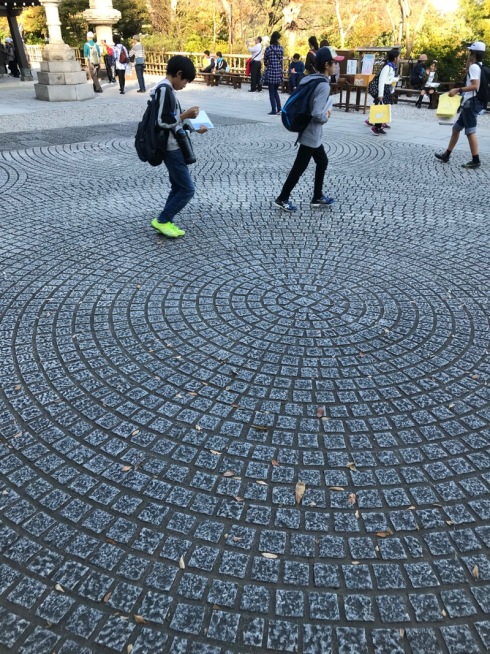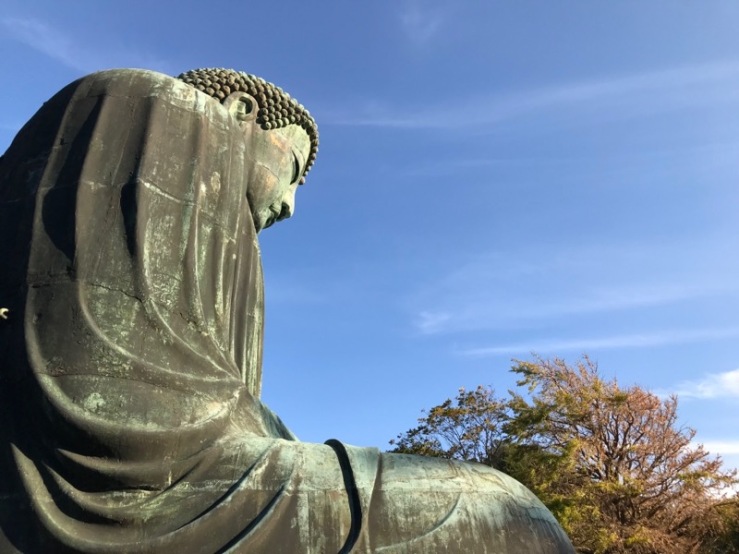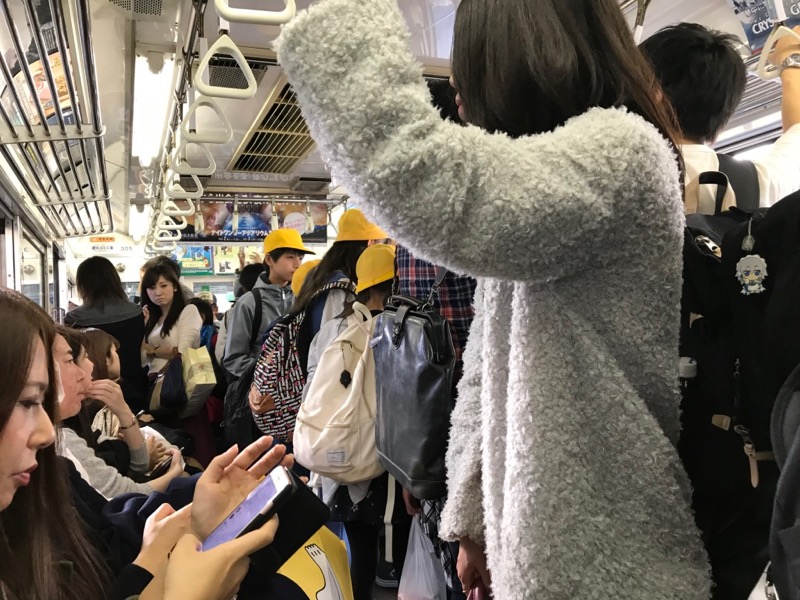This is post #5 of our Tokyo-Seoul trip, for the second half of Tuesday, November 7, 2017, a continuation of the previous post.
After walking back to the station, we are hungry and tired and maybe even a little bit hangry, so we both hit the gift shop looking for something to eat. It’s a maze, so we miss each other coming out (typical) but eventually reunite. I bought two drinks, which we guzzle down and Dave bought a French pastry with chocolate chips — er, red beans. Still can’t get used to finding beans in all my food. We join the other masses of school children to ride the Enoden, the electric train. We all pile on when it arrives, and it’s a noisy, happy two-stop ride to where we get off.

We are headed to the Hasedera Temple, but we all wait on the platfrom for the train to pass, then go down the steps, crossing the other tracks, and through the trestle-arm gates. 
We turn left by the tsunami signs (sobering, as I watched many videos of the tsumani that hit Japan in 2011) and walk a short distance to the shrine. As with so many of these shrines and temples, the origins read much like my religion’s crickets-and-seagulls story, examples of God’s divine providence, but perhaps unintelligible to other peoples from other lands. This one had to do with a sacred large camphor tree, a stump carved like a Kannon statue which was then thrown into the sea only later returning, and a temple constructed to honor and house it. We enter the grounds, pay our entry fee and start up a winding path to the top of the hill.
Along the way were many small statues: “Along the steps to the Kannondo are statues of a much less monumental size but perhaps greater visual impact. All around are rows of small statues of Jizo, the guardian deity of children. Historically, parents came to Hasedera to set up these statues in hopes the deity would protect and watch over their children. Today, though, the Jizo statues represent the souls of miscarried, stillborn or aborted children. Some of the statues are dressed in bibs, hand-knitted caps and sweaters. More than 50,000 Jizo statues have been offered here since the war, but the thousand or so currently displayed will remain only a year before being burned or buried to make way for others.” (from here)

Small reflecting pond next to the garden of statues

Sign at one turn of the steps on the way up to the Kannon-do Hall, at the top of the site.



This was my favorite of the temples, with its stark black-and-white, the pristine nature of the grounds and the view to the sea. It’s sometimes easy to forget we are on an island:

I do like the vermillion temples, but this was so different looking. Inside the main hall is a giant goddess of Mercy statue (no photos allowed, except for the one from the tourist site, below).

I was attracted to a small area to the side, where you could write down the name of a woman who had had a miscarriage and submit it (with a small fee) to the priests, who would pray for the mother and the unborn baby. I thought of my daughter and all the miscarriages she’d had before getting her last child over a decade ago. I could see her coming to this place, and writing down her name here. But we also have collections of names in our Latter-day Saint temples that we pray for, and we don’t need to offer up money. Her name was in those temples a lot in those days.


This shrine was originally dedicated to Kojin, the god of the cooking stove and fire, but it has been rebranded as Inari-sha, due to the presence of the oyster shells attached to the carved stump that found its way back to the land (all info is from the brochure).






I sat and waited for my book to be signed (or, I waited for my “go-shuin”), while Dave explored the grounds. He saw the small smiling statues, the footprint of Buddha, the Benten-jutsu Cave and other sights:
 These ice creams in the vending machine are tempting, as I am flagging because of no lunch, but we press on.
These ice creams in the vending machine are tempting, as I am flagging because of no lunch, but we press on.
We leave the Hasedera Temple and walk up the hill to the Kotokuin Temple, pay the money and enter. Immediately we can glimpse the giant Buddha. We are there with (it seems) entire legions of elementary school children, who are happy and noisy and very charming. (I wonder if American schoolchildren are this polite.)

I head to the building to the right to get my go-shuin; Dave sits down on one of the big rocks in the area, while I take photos and explore.





Apparently you can go inside (for an additional fee) the Daibutsu of Kamakura (what they call it). Cast in about 1252, he has sat in the open air since around 1492, when the temple that used to surround him was destroyed.

A woodblock from the late 19th century shows one view, but all the trees are grown now, so we couldn’t see the sea from this temple. However, we did see many schoolchildren.

I wanted to take a photo of one young man’s hat ON him, and asked him (that old thing where I think they understand English). He takes off his hat, and says, with eyes downcast, “Sorry.”
I realize he thinks I’m telling him to take off his hat in deference to the Buddha. I hold up my iPhone. “No,” I smile “Photo?” and his friend whaps him on the arm and says something in Japanese with the word “foto” in it.
He grins and let me take the photo of his hat. I still remember the time in Dubrovnik when the little boy, well-trained by his parents to deal with pesky tourists, screamed NOOOOOOOO!! when someone asked to take his photo. I’m more cautious now.
I do wish I had a hat with a slogan that reads “Every Day Full of Drive.”

I picked up my signing book, Dave, and we head toward the bus.


Dave snaps this photo as we leave; when we look at it later, the monk’s expression seems to say “You tourists.”




You can see the divide here right down the center of the subway train car, as people face toward the windows.

She likes ruched flowers.

Home.
 Up on the street, the neon lights start their performances, and we think about dinner.
Up on the street, the neon lights start their performances, and we think about dinner.

This is about a one-minute walk from our hotel/subway stop, and we decide to try it out, given our success yesterday. Note the wax food display on the outside, left.



Where are the chopsticks? In a little drawer on the table, underneath the condiments. Dave has vegetable ramen, I had tonkatsu and we share lightly refried rice and six gyoza, which were really delicious. The whole meal hit the spot.

Two specials. Or something. Right as we finish, the lady at the next table lights up a cigarette. Apparently smoking is not allowed on the street, but okay in this restaurant during these hours:

No smoking on the first floor between 7 a.m. and 5 p.m, and on the 2nd floor between 7 a.m. and 3 p.m. We asked about these hours; apparently it’s so women and their children aren’t exposed to second-hand smoke, or at least it’s what the hotel clerk told us.

We walk the block to our hotel, and enter the elevator, knowing that we are being watched:


I lay my collection of ema and go-shuin on the bed and admire them all. I still have my treasured books from our last trip, and now have another new one for my collection.

I record today’s purchases, and write in my journal. And I hope for a good night’s sleep for tomorrow’s a big day: Dave starts his conference and I try to find my way to buy a Blythe doll.


























The monument to lost babies/miscarriages is so tender! I love it! I also love how respectful the Japanese people are, which you mention in a few different places in this post. That’s so unfamiliar to us in the U.S.